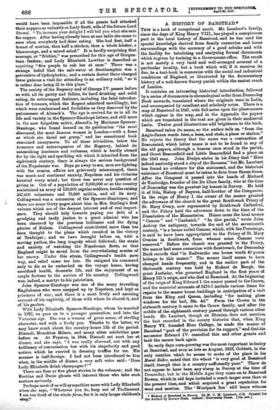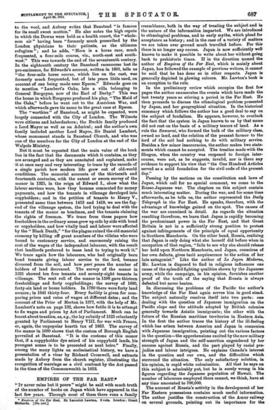A HISTORY OF BANSTEAD.* Tito is a book of exceptional
merit. Mr. Lambert's family, since the days of King Henry VIII., has played a conspicuous part in the local history of Banstead, and be has used the special knowledge derived from family connexion and home surroundings with the accuracy of a good scholar and with the facility for tabulating and analysing formal documents which is given by training in a Government office. The result is not merely a very lucid and well-arranged account of a particular locality, but a book which will, if it receives its due, be a text-book in connexion with the social and industrial conditions of England, as illustrated by the documentary history of a well-known Surrey parish within the easiest reach of London.
It contains an interesting historical introduction, followed by a series of documents in chronological order from Domesday Book onwards, translated where the originals were in Latin, and accompanied by excellent and scholarly notes. There is a map of Banstead in 1847, with full notes upon the place-names which appear in the map, and in the Appendix the papers which are translated in the text are given in their mediaeval Latin. Twelve good illustrations add brightness to the book.
Banstead takes its name, so the author tells us, "from the Anglo-Saxon words bean, a bean, and sted,e, a place or station." He rejects the theory that the name was a contraction of Beaconsted, which latter name is not to be found in any of the old papers, although a beacon once stood in the parish, and Great Beaconfield and Little Beaconfield find a place on the 1841 map. John Evelyn states in his Diary that "Here indeed anciently stood a city of the Romans," but Mr. Lambert has found no evidence for this statement, and the historical existence of Banstead must be taken to date from Saxon times. After the Conquest it passed into the hands of Richard sle Tonbridge, founder of the De Clare family, who at the time of Domesday was the greatest lay tenant in Surrey. He held it of Oda, Bishop of Bayeux, half-brother of the Conqueror. In the reign of Henry I. the owner of the manor granted the advowson of the church to the great Southwark Priory of St. Mary Overy, now represented by Southwark Cathedral, and the Priory held the advowson down to the time of the Dissolution of the Monasteries. Hence came the local names " Canons " and " Canhatch." "In this parish," wrote John Aubrey the antiquary, towards the end of the seventeenth century, "is a house called Canons, which, with the Parsonage, is said to have been appropriated to the Priory of St. Mary Overies in Southwark, from whence some Canons were removed." Before the church was granted to the Priory, the manor had some connexion with Southwark, for Domesday Book records that "in Sudwerche one house worth 40 pence belongs to this manor." The manor itself seems to have changed hands frequently, and in the earlier part of the thirteenth century was held by Hubert de Burgh, the great Justiciar, who governed England in the first years of Henry ILL' reign, and who died at Banstead. At the beginning of the reign of King Edward I. the manor passed to the Crown, and the manorial accounts of 1276-7 include various items for repairs to the manor house buildings in anticipation of a visit from the King and Queen, including "for making glass windows for the hall, 33s. 4d." From the Crown in the sixteenth century it came to the Carew family, and after the middle of the eighteenth century passed through various other bands. Mr. Lambert, though an Etonian, does not mention the fact recorded in the county histories that, when King Henry VI. founded Eton College, be made the manor of Banstead "part of the provision for its support," and that his successor Edward IV. cancelled this and other grants and took the manor back again.
In early days corn-growing was the most important industry at Banstead, and even as late as August, 1823, Cobbett, in the only mention which he seems to make of the place in his Rural Bides, noted that the wheat "is very good at Banstead itself, though that is a country sufficiently poor." There do not appear to have been any sheep in Surrey at the time of Domesday, but in the Middle Ages they came on to Banstead Downs, which in old days included a much larger area than at the present time, and which acquired a great reputation for wool and mutton. The Woolpack still bears witness
• History of Poi:Instead in Surrey. By H. C. AL Lambert, C.B. Printed for the Author by Horace Hart. Oxford : University Press. I:21s. net.]
to the wool, and Aubrey writes that Banstead "is famous for its small sweet mutton." He also notes the high repute in which the Downs were held as a health resort, the " whole- som air" having been "formerly much prescribed by the London physicians to their patients, as the ultimum refugium "; and he adds, "Here is a horse race, much frequented, a four-mile course, viz., north-east and south- west." This was towards the end of the seventeenth century. In the eighteenth century the Banstead racecourse lost its pre-eminence, for Edwards's account, written in 1801, tells us "the four-mile horse course, which lies on the east, was formerly much frequented, but of late years little used, on account of one being made near Epsom." Edwards goes on to mention " Lambert's Oaks, late a villa belonging to General Burgoyne, now of the Earl of Derby." This was the house in which Burgoyne produced his play, "The Maid of the Oaks," before he went out to the American War, and which afterwards gave its name to the great race at Epsom.
The " worthies " of Banstead, as might be expected, were largely connected with the City of London. The Wilmots were citizens and haberdashers; the Buckle family produced a Lord Mayor as well as an Admiral; and the author's own family included another Lord Mayor, Sir Daniel Lambert, whose monument stands in Banstead Church, and who was one of the members for the City of London at the end of the Walpole Ministry.
But it must be repeated that the main value of the book lies in the fact that the documents which it contains, as they are arranged and as they are annotated and explained, make it at once easy and very interesting to trace by the records of a single parish how modern life grew out of old-world conditions. The manorial accounts of the thirteenth and fourteenth centuries, with the extent or sworn survey of the manor in 1325, in the reign of Edward I., show what the labour services were, how they became commuted for money payments, and how the tenants in villenage developed into copyholders ; and in the petition of tenants to Henry V., presented some time between 1413 and 1419, we see the fag- end of the villenage system, the lord trying to deal with the tenants of the manor as bondmen, and the tenants claiming the rights of freemen. We trace from these papers how freeholders in the ordinary sense grew up side by side with bond or copyholders, and how vitally land and labour were affected by the "Black Death," "for the plague ruined the old manorial economy by killing off great numbers of the villeins who were bound to customary service, and enormously raising the cost of the wages of the independent labourer, with the result that landlords preferred to lease land to trying to work it." We trace again how the labourers, who had originally been bond tenants giving labour service to the lord, became divorced from the soil, and bow pan i passu the number of holders of land decreased. The survey of the manor in 1325 showed ten free tenants and seventy-eight tenants in villenage. The rent roll of the manor in 1598 gave thirteen freeholdings and forty copyholdings; the survey of 1680, forty-six land or house holders. In 1780 there were forty land owners ; in 1841 thirty-four. Every facility is given for com- paring prices and rates of wages at different dates; and the account of the Prior of Merton in 1377, with the help of Mr. Lambert's note on page 132, shows how futile it is to attempt to fix wages and prices by Act of Parliament. Much can be learnt about taxation, as, e.g., the lay subsidy of 1525 reluctantly granted by Parliament to Henry VIII. for war with France, or, again, the unpopular hearth tax of 1663. The survey of the manor in 1680 shows that the custom of Borough English prevailed at Banstead. "It is the custom° of this manor that, if a coppyholder dye seized of his coppyhold lands, his youngest Bonne is to be presented as next heire." Finally, among the many lights on ecclesiastical history, we have a presentation of a vicar by Richard Cromwell, and extracts made by Aubrey from the church register, illustrating the recognition of marriage as a civil contract by the Act passed in the time of the Commonwealth in 1653.



























































 Previous page
Previous page